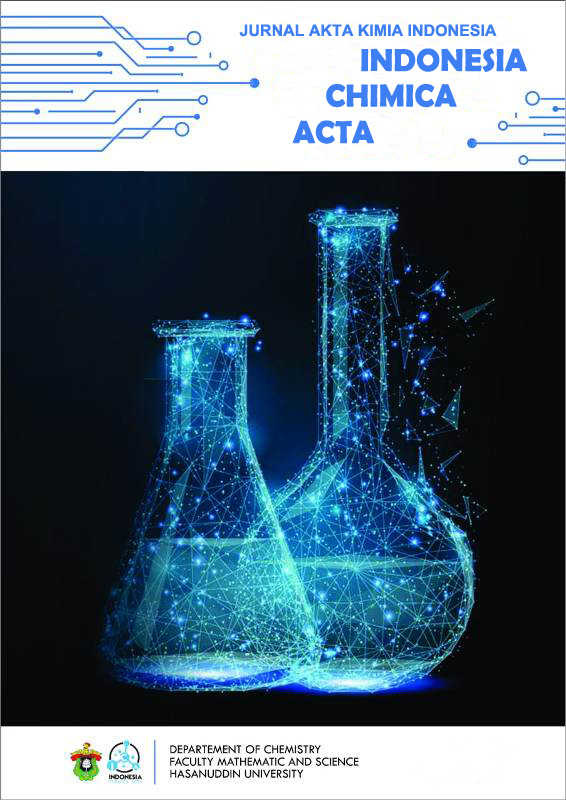Synthesis Of Glycerol Carbonate From Glycerol And Urea Using Limestone As Catalyst Source
DOI:
https://doi.org/10.20956/ica.v12i2.8096Keywords:
Glycerol Carbonate, Catalyst, LimestoneAbstract
Synthesis of Glycerol carbonate from glycerol and urea using limestone as a catalyst has been conducted. This study aims to make glycerol carbonate from glycerol and urea by utilizing scattered natural limestone widespread in Southeast Sulawesi as a catalyst source. The catalyst was obtained from the calcination of natural limestone to decompose CaCO3 to CaO. This condition added to glycerol and urea to test the catalyst activity. Synthesis of glycerol carbonate was carried out through the carbamoylation reaction of glycerol with urea. The advantage of this method is the reaction carried out with free solvents and running in ambient pressure (1 atm). The stages of catalyst testing in the reaction of glycerol carbonate formation were carried out by reacting glycerol, urea, and calcined limestone with 1: 1 substrate mole ratio with a catalyst concentration of 5% mass over glycerol. Characterization used was Fourier Transform Infrared Spectroscopy (FTIR) and supported by Gas Chromatography (GC) data. Optimization catalysis reaction was obtained at a temperature of 140oC for 4 hours and using a catalyst mole ratio to 5% substrateReferences
Adhitasari, A., Sulistyo, H., dan Prasetya, A., Synthesis of Glycerol Carbonate from Glycerol and Urea Using Indion Resin Catalysts 225 Na, Reaktor, 2017, 17(3) :139-143
Damayanti, O. Synthesis of Glycerol Carbonate From Glycerol With Nickel Based Catalysts. Institut Teknologi Sepuluh Nopember, Surabaya. Jurnal Teknik ITS, 2012, 1( 1): 2301-9271
Hammond,C., Lopez-Sanchez, J.A., Ab Rahim, M.H., Dimitratos, N., Jenkins, R.L., Carley, A.F., He, Q., Kiely, C.J., Knight, D.W., Hutchings, G.J. Synthesis of Glycerol Carbonate From Glycerol and Urea With Gold-Based Catalysts. Dalton Trans 2011,40 : 3927–37
Jimmy, Nilna, F., Huda, M.I., Jehadu, Y.M., Synthesis of Glycerol Carbonate from Glycerol (Biodiesel Industrial Residue) with Variations Reactant Ratios and Reaction Times, National Seminar on Technology 2015, National Technology Institute of Malang
Lailiyah, Q., Baqiya, M., Darminto. Effect of Temperature and Flow Rate of CO2 Gas on Synthesis of Calcium Carbonate Precipitate by Bubbling Method. Jurnal Sains dan Seni ITS, 2012,Vol. 1(1)
Lukman, M., Yudyanto., Hartatiek. Synthesis of CaO-SiO2 Composite Biomaterials Based on Natural Materials (Limestone and Quartz Sand) with Heating Temperature Variations and Their Effects on Porosity, Hardness and Microstructure. Journal Sains 2012, 2(1).
Ochoa-Gómez, J. R. Synthesis of glycerol carbonate from glycerol and dimethyl carbonate by transesterification: Catalyst screening and reaction optimization. Appl. Catal. A Gen, 2009 .366 : 315–324
Rubio-Marcos, F., Calvino-Casilda, V., Bañares, M. a. & Fernandez, J. F. Novel hierarchical Co3O4/ZnO mixtures by dry nanodispersion and their catalytic application in the carbonylation of glycerol. J. Catal 2010 . 275 : 288–293.
Sucipto, E., (2007). The Relationship of Dust Particle Exposure to Limestone Processing to Lung Capacity Decrease. Semarang: Diponegoro University.
Turney, T. W., Patti, A., Gates, W., Shaheen, U. & Kulasegaram, S. Formation of glycerol carbonate from glycerol and urea catalysed by metal monoglycerolates. Green Chem 2013.15 : 19-25
Wang, L., Ma, Y., Wang, Y., Liu, S. & Deng, Y. Efficient Synthesis Of Glycerol Carbonate From Glycerol And Urea with Lanthanum Oxide As a Solid Base Catalyst. Catal. Commun 2011, 12 :1458–1462.
Zhang, Y., Dubé, M., McLean, D.& Kates, M. Biodiesel Production From Waste Cooking oil: 2. Economic Assessment and Sensitivity Analysis. Bioresour. Technol. 2003, 90 : 229–240
Downloads
Published
Issue
Section
License
This is an open access journal which means that all contents is freely available without charge to the user or his/her institution. Users are allowed to read, download, copy, distribute, print, search, or link to the full texts of the articles in this journal without asking prior permission from the publisher or the author.
Jurnal Akta Kimia Indonesia (Indonesia Chimica Acta) operates a CC BY-SA 4.0 © license for journal papers. Copyright remains with the author, but Jurnal Akta Kimia Indonesia (Indonesia Chimica Acta) is licensed to publish the paper, and the author agrees to make the article available with the CC BY-SA 4.0 license. Reproduction as another journal article in whole or in part would be plagiarism. Jurnal Akta Kimia Indonesia (Indonesia Chimica Acta) reserves all rights except those granted in this copyright notice.



